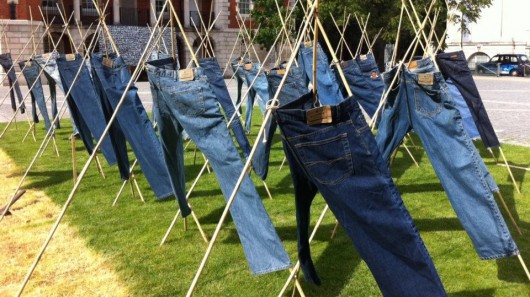Liquid laundry additive turns clothes into air purifiers
By Darren Quick
October 1, 2012
A laundry additive created by researchers from the University of Sheffield and the London College of Fashion turns clothing into a photocatalytic material that can help remove nitrogen oxides (NOx) from the air. One of the most prominent air pollutants, nitrogen oxides are emitted from the exhausts of ICE-powered vehicles and aggravate asthma and other respiratory diseases. The researchers claim one person getting around town in clothing treated with the additive for a day would be able to remove roughly the same amount of nitrogen oxides produced by the average family car each day.
Dubbed “CatClo,” (short for Catalytic Clothing), the liquid laundry additive contains pollution-eating titanium dioxide (TiO2) nanoparticles that, in daylight, oxidize the nitrogen oxides in the fabric when they come into contact with them in the air. The treated nitrogen oxides, which are odorless, colorless and pose no pollution hazard, are then either dissipated harmlessly in the wearer’s sweat of removed in the next wash.
The researchers say the additive itself is also completely harmless and unnoticeable to the wearer. Additionally, because the TiO2 nanoparticles grip to fabrics very tightly, items of clothing only need to be washed in the additive once.
Because the additive is photocatalytic, meaning that the chemical reaction requires light to take place, the clothing best performs its air-purifying magic when worn out in daylight. The researchers claim CatClo treated clothing can remove around 5 grams of nitrogen oxides from the air in the course of a day, which is roughly equivalent to the amount of nitrogen oxides emitted from the exhaust of an average family car each day.
The additive was used to create Wendy, the 14-meter (46 ft) high air-purifying sculpture covered in nylon fabric sprayed with CatClo that was on display at New York’s Museum of Modern Art (MoMA) earlier this year. The researchers say that over a 10-week period, Wendy soaked up nitrogen oxides equivalent to the amount produced by around 260 cars.
“If thousands of people in a typical town used the additive, the result would be a significant improvement in local air quality”, says Professor Ryan OBE of the University of Sheffield. “This additive creates the potential for community action to deliver a real environmental benefit that could actually help to cut disease and save lives. In Sheffield, for instance, if everyone washed their clothes in the additive, there would be no pollution problem caused by nitrogen oxides at all.”
The researchers say that as well as the benefits to general air quality, individuals with respiratory conditions could also improve the quality of the air they breathe by wearing clothes treated with CatClo.
The additive is said to function particularly well on denim, which is why a “Field of Jeans” display highlighting the benefits of the technology will be featured as part of the Manchester Science Festival that runs from October 27 to November 4.
The research team is currently working with a manufacturer to bring CatClo to market, with Professor Ryan estimating that using the additive in a final rinse of a full washing load would potentially cost as little as 10 pence (approx. US$0.16).
Source: University of Sheffield
About the AuthorCopyright © gizmag 2003 - 2012 To subscribe or visit go to: http://www.gizmag.com

